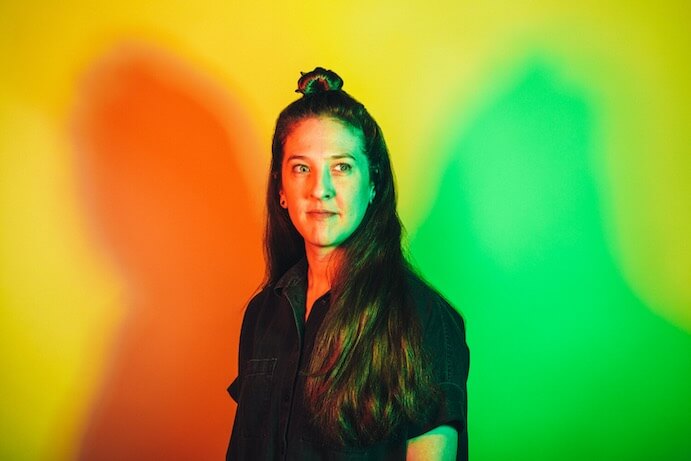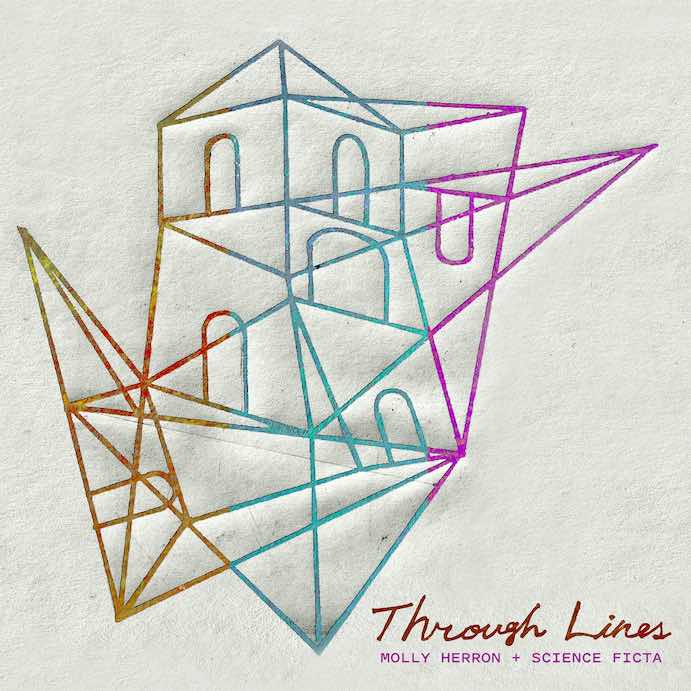Composer Molly Herron explores a vast landscape of musical and temporal intersections in Through Lines, her latest album out August 27, 2021 on New Amsterdam Records. Using the historical instrument viola da gamba (or viol) as a vehicle to connect past to present, Herron composed the seven pieces and four interludes in collaboration with viol ensemble Science Ficta, who expertly perform on the album.
Herron reimagines the traditional musical form of the canon in Canon No. 3 and Canon No. 2. Canon No. 3 immediately establishes a dominant-tonic relationship, echoing Baroque compositional choices, but opens with a passage that evokes the indeterminacy of wind chimes: tonally connected, yet unpredictable. Herron also plays with articulation and timbre, which familiarizes the listener with the viol’s wide range of expression. The result is a piece that is at once anchored and fluid. As if to reassemble the first track, Canon No. 2 begins with a more familiar reference to a conventional canon. A theme is passed between each of the instruments, but Herron also divides thematic material between them, as if the viols finish each other’s melodic sentences. Later in the piece, Herron brings together techniques of Baroque composition and minimalism.

Molly Herron–Photo by Catalina Kulczar
Interludes 1, 2, 3, and 4 are interspersed throughout the album and each focus on the viol’s capabilities of expressiveness within the harmonic series, evoking a modern, spectral aesthetic. The first of the interludes gently introduces the timbral breadth of the instrument. Interlude 2 highlights the tight blend and technical expertise of Science Ficta by exploring bow pressure and articulation. In Interlude 3, Herron shows the dissonant parts of the harmonic series by obscuring the piece’s governing fundamental with discordant harmonies. Interlude 4 provides a light break in an intense part of the album with soothing consonant chords that pause the focus on melodic material.
In Trill and Roll, Herron pushes concepts of Baroque ornamental technique out of their historical contexts to become the hyperfocus of each piece. In Trill, Herron highlights the tremendous significance of the musical ornament by composing an almost nonstop series of trills. At times, she aligns trill with melody, while at other moments, each of the violas da gamba seem to trill in such close relationships that they make a sort of Venn diagram pitch cluster uncommon to Baroque harmony. Similarly, Roll highlights the technique of arpeggiating a chord across all of the viol’s strings. Herron shows the dramatic intensity and volume of the viola da gamba through consecutive, layered rolled chords in relative harmonic stasis. The casual listener might get pleasantly lost within the sounds of these pieces, while deep listening reveals smartly crafted layers of historical and contemporary ideas.
After Picforth highlights the caramelly richness of the viol. Herron drew inspiration from the 16th-17th century British composer Picforth — only one of his manuscripts, In Nomine, remains while the others have been lost to history. Picforth interestingly assigned the five voices in his piece one rhythmic value, and each voice gets a unique rhythm. As if to pay homage to In Nomine, Herron begins her piece in a slow, minor chorale before each viol interjects subtle and fast interruptions, almost as if the instruments are gossiping with each other. Soon, the chatter becomes more pronounced while the solemn chorale fades. Just as fast as the piece climaxes, it ends, and leaves the listener wondering what could not wait to be said.
In these and the other tracks on Through Lines, Molly Herron thoughtfully establishes a connection between a historical instrument and contemporary compositional techniques that are links in a chain across time. In an almost Grisey-esque way, Herron holds the sound of the viol under a microscope, expanding its sound and meaning. In negotiating the space between the conventional and the unconventional, she also creates a connection between composers of the past and herself, a thoughtful and skilled composer of the 21st century.
I CARE IF YOU LISTEN is an editorially-independent program of the American Composers Forum, funded with generous donor and institutional support. Opinions expressed are solely those of the author and may not represent the views of ICIYL or ACF.
A gift to ACF helps support the work of ICIYL. For more on ACF, visit the “At ACF” section or composersforum.org.























